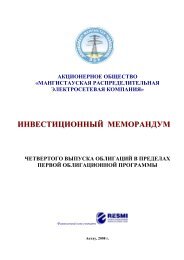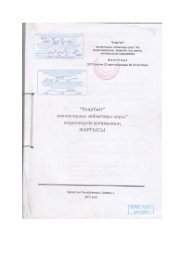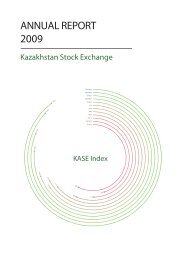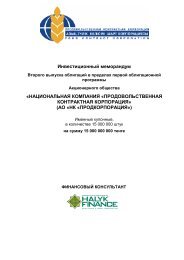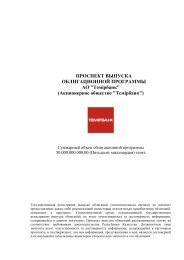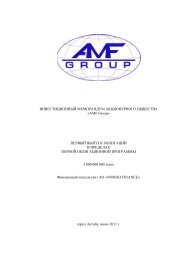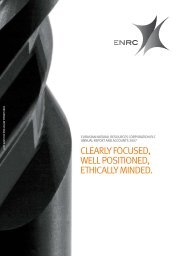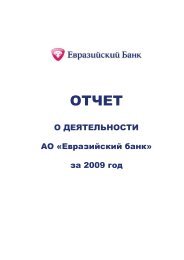Download
Download
Download
Create successful ePaper yourself
Turn your PDF publications into a flip-book with our unique Google optimized e-Paper software.
Notes to the Consolidated<br />
Financial Statements<br />
KZT millions, unless otherwise stated<br />
production rates for DD&A. The Company has included in<br />
proved reserves only those quantities that are expected to<br />
be produced during the initial license period. This is due to<br />
the uncertainties surrounding the outcome of such renewal<br />
procedures, since the renewal is ultimately at the discretion<br />
of the Government. An increase in the Company’s license<br />
periods and corresponding increase in reported reserves would<br />
generally lead to lower DD&A expense and could materially<br />
affect earnings. A reduction in proved developed reserves<br />
will increase DD&A expense (assuming constant production),<br />
reduce income and could also result in an immediate writedown<br />
of the property’s book value. Given the relatively small<br />
number of producing fields, it is possible that any changes<br />
in reserve estimates year on year could significantly affect<br />
prospective charges for DD&A.<br />
Recoverability of oil and gas assets<br />
The Company assesses each asset or cash generating<br />
unit (CGU) every reporting period to determine whether<br />
any indication of impairment exists. Where an indicator of<br />
impairment exists, a formal estimate of the recoverable amount<br />
is made, which is considered to be the higher of the fair value<br />
less costs to sell and value in use. These assessments require<br />
the use of estimates and assumptions such as long-term oil<br />
prices (considering current and historical prices, price trends<br />
and related factors), discount rates, operating costs, future<br />
capital requirements, decommissioning costs, exploration<br />
potential, reserves and operating performance (which<br />
includes production and sales volumes). These estimates and<br />
assumptions are subject to risk and uncertainty. Therefore,<br />
there is a possibility that changes in circumstances will impact<br />
these projections, which may impact the recoverable amount<br />
of assets and/or CGUs. Fair value is determined as the amount<br />
that would be obtained from the sale of the asset in an arm’s<br />
length transaction between knowledgeable and willing parties.<br />
Fair value for oil and gas assets is generally determined as the<br />
present value of estimated future cash flows arising from the<br />
continued use of the assets, which includes estimates such as<br />
the cost of future expansion plans and eventual disposal, using<br />
assumptions that an independent market participant may take<br />
into account. Cash flows are discounted to their present value<br />
using a discount rate that reflects current market assessments<br />
of the time value of money and the risks specific to the asset.<br />
Management of the Company has carried out a formal<br />
assessment of the recoverable amount of JSC “Ozenmunaigas”<br />
due to the presence of impairment indicators. The main<br />
indicators were the level of production being materially<br />
lower than planned in the last two years and the increasing<br />
levels of operational and capital expenditure. The result of<br />
this assessment indicated that the carrying value of JSC<br />
“Ozenmunaigas” assets exceeded the estimated recoverable<br />
amount by 75 billion Tenge, resulting in an impairment charge<br />
during 2012 (Note 6, 20). The estimated recoverable amount<br />
was based on management’s estimate of its fair value, which<br />
was derived using discounted cash flow approach. The results<br />
of the assessment were most sensitive to assumptions related<br />
to production and pricing.<br />
The assumed production profile was based on an assessment<br />
performed by accredited third party oil and gas consultants<br />
that envisages growth of more than 20% in production within<br />
four years. If the production profile had been assumed to be<br />
5% higher or lower than the assumed production profile used<br />
in the assessment, this would have had the effect of reducing<br />
impairment by more than 55 billion Tenge or increasing<br />
impairment by more than 55 billion Tenge, respectively. If<br />
production had been assumed to have remained fixed at<br />
the 2012 level, the impairment would have been over 200<br />
billion Tenge.<br />
Brent crude oil price assumptions were based on market<br />
expectations together with the expectations of an independent<br />
industry analysis and research organization, adjusted for the<br />
average realized historical discount on quoted price. If Brent<br />
crude oil prices had been assumed to be 5% higher or lower<br />
than the price assumptions used in the assessment, this would<br />
have had the effect of reducing impairment by more than 40<br />
billion Tenge or increasing impairment by more than 40 billion<br />
Tenge, respectively.<br />
The projection of cash flows was limited by the date of license<br />
expiry in 2021. Expenditure cash flows up to 2017 were<br />
obtained from the approved budget and business plan of the<br />
Company. Most of the projections beyond that period were<br />
inflated using Kazakhstan inflation estimates, except for capital<br />
expenditure projections, which represent management’s best<br />
available estimate as at the date of impairment assessment.<br />
For the purposes of the assessment it was assumed that<br />
management would not be able to significantly reduce<br />
operational or capital expenditure in the final years before<br />
license expiry in order to make cost savings. An exchange rate<br />
of 150.45 KZT/USD, which is the official exchange rate as at<br />
the date of the impairment assessment, was used to convert<br />
US Dollar denominated sales. All the derived cash flows were<br />
discounted using after tax weighted average cost of capital<br />
(“WACC”) of 13.09%.<br />
Management believes that the resulting impairment charge<br />
on JSC “Ozenmunaigas” assets could be reversed in future<br />
periods if actual production over the next years exceeds<br />
expectations used in this impairment assessment or if there<br />
are indicators of sustainable increases in market prices for<br />
crude oil.<br />
Asset retirement obligations<br />
Under the terms of certain contracts, legislation and regulations<br />
the Company has legal obligations to dismantle and remove<br />
tangible assets and restore the land at each production site.<br />
Specifically, the Company’s obligation relates to the ongoing<br />
closure of all non-productive wells and final closure activities<br />
such as removal of pipes, buildings and recultivation of the<br />
contract territories. Since the license terms cannot be extended<br />
at the discretion of the Company, the settlement date of the<br />
final closure obligations has been assumed to be the end of<br />
each license period.<br />
If the asset retirement obligations were to be settled at the<br />
end of the economic life of the properties, the recorded<br />
obligation would increase significantly due to the inclusion of all<br />
abandonment and closure costs. The extent of the Company’s<br />
obligations to finance the abandonment of wells and for final<br />
closure costs depends on the terms of the respective contracts<br />
and current legislation. Where neither contracts nor legislation<br />
include an unambiguous obligation to undertake or finance<br />
such final abandonment and closure costs at the end of the<br />
license term, no liability has been recognized. There is some<br />
uncertainty and significant judgment involved in making such<br />
a determination. Management’s assessment of the presence<br />
or absence of such obligations could change with shifts in<br />
86<br />
Annual report 2012 KazMunaiGas Exploration Production JSC





